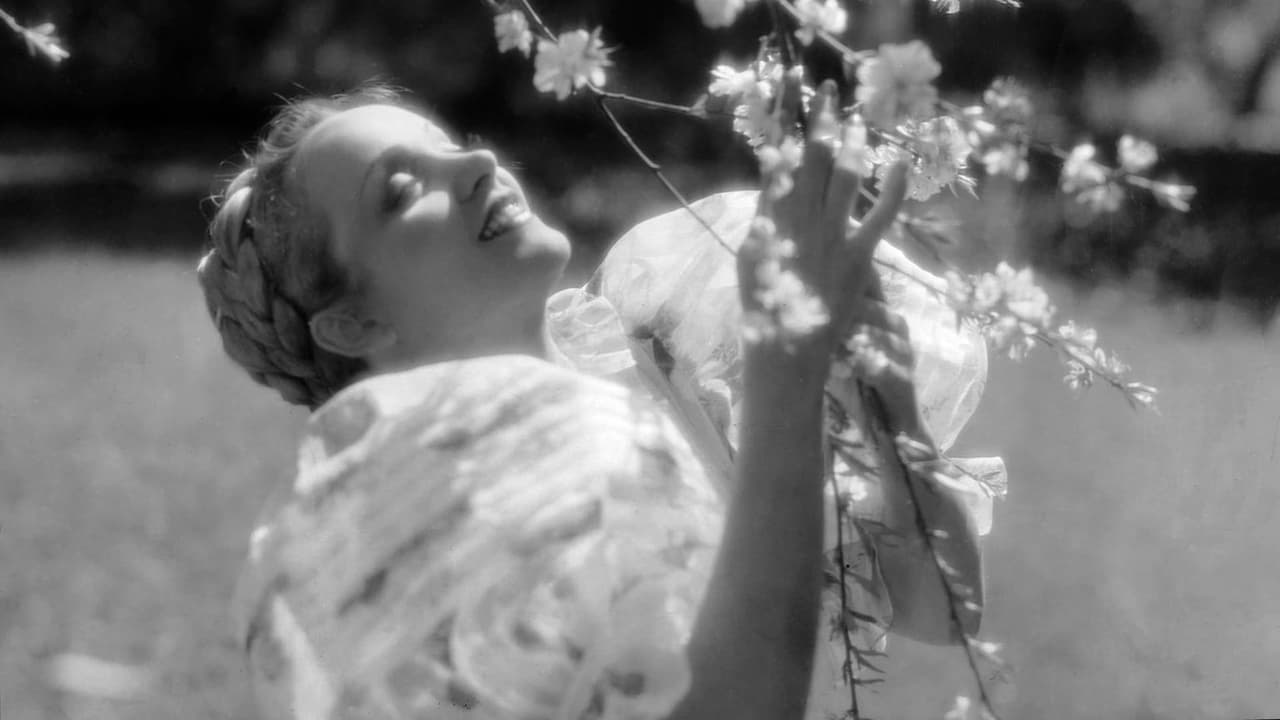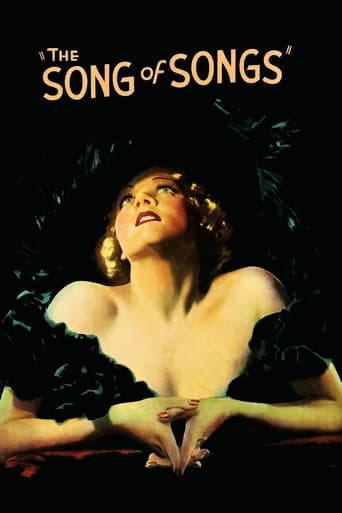

This picture was a big reversal for Marlene Dietrich. Besides her first picture without Von Sternberg as director, it is the first one in which she goes from ingenue to demi-monde, instead of starting out as one. Here she is cast as a country girl who comes to the big city and befriends a sculptor of nudes (Aherne). She becomes his model, until he kisses her. Then the scales fall from their eyes and she becomes his lover. It is an extremely effective scene.Matters evolve (or devolve) as a Prussian Colonel (Lionel Atwill) also takes an interest in his model. Atwill, who normally plays diabolical and unsavory types, has one of his best roles as a lecherous soldier and plays it to the hilt. It is a riveting portrayal and commands your attention whenever he is on screen. Alison Skipworth, one of Hollywood's best character actresses, plays her dipso aunt in what is her best role since "Outward Bound".The storyline is not the thing here but it is fascinating to watch a master like Mamoulian at work and to watch Dietrich play against type, as well as watching the aforementioned Atwill in a performance that is sublime. Those are the surprises, not the plot - it's been done many times before and since.
... View MoreTHE SONG OF SONGS (Paramount, 1933), directed by Rouben Mamoulian, from the novel by Hermann Sudermann and play by Edward Sheldon, was released at a time when movie musicals proved popular again following an over abundance of them produced during the 1929-30 dawn of sound era. With the new cycle of successful musicals that began with 42nd STREET (Warners, 1933), THE SONG OF SONGS doesn't fit into that category in spite of its musical sounding title. In fact, it's a dramatic story about a German peasant girl named Lily who dreams about becoming like her favorite character from the Bible's "Song of Songs." Lily, as portrayed by Marlene Dietrich, appears in her fifth Hollywood production. Unlike her previous screen efforts ranging from her initial starring success in Germany's THE BLUE ANGEL (1929), to Hollywood's MOROCCO (1930), DISHONORED (1931), SHANGHAI EXPRESS (1932) and BLONDE VENUS (1932), all under the direction of Josef Von Sternberg, THE SONG OF SONGS provides her with another director whose direction paved the way for a new and different Dietrich persona. The story revolves around Lily Czepanek (Marlene Dietrich), a shy German girl leaving the grave of her father for the next train to Berlin where she is to live with her aunt, Frau Rasmussen (Alison Skipworth). Working in her aunt's book store, Lily captures the attention of Richard Waldow (Brian Aherne), a young sculptor living across the street who selects her as his next model. Discovering she'll have to pose in the nude, Lily at first declines but after his assurance that he has no interest in her, she agrees to become the replica of the proposed statue he calls "The Song of Songs." When the aunt learns Lily has been sneaking out while asleep, she whips her. When all else fails, she turns her out into the street. With no where else to go, Lily, who has fallen in love with Waldow, comes to his studio only to find his best friend, August Von Merzbach (Lionel Atwill), a middle-aged baron, awaiting her with the news of Waldow leaving for Italy with no promise of returning. Desperately in love with Lily because of Waldow's statue, the Baron talks her into marrying him instead. Acquiring culture through French lessons, piano playing and social functions, Lily stirs up jealousy from Fraulein Von Schwartzfegger (Helen Freeman), the Baron's housekeeper, who soon arranges for Lily to have Edward Von Prell (Hardie Albright) act as her lover in hope of destroying both her reputation and marriage with the Baron.With so many motion pictures made and remade, THE SONG OF SONGS was one that had, not one, but two earlier screen adaptations from the silent era each by Paramount: 1918 with Elsie Ferguson, and 1924 as LILY OF THE DUST starring Pola Negri. Aside from some European style camera techniques, THE SONG OF SONGS comes off best with its fine photography by Victor Milner and impressive musical score by the uncredited Nathaniel W. Finston. Mamoulian, a stylish director in his own right, quite different from Von Sternberg, brings out the best in Dietrich's performance from shy/ innocent girl to scandalous lady of confidence singing "Jonny" (by Frederick Hollander and Edward Heyman) in a night club. Von Sternberg would borrow this transformation style for Dietrich as Catherine the Great in his upcoming production of THE SCARLET EMPRESS (1934). Although Mamoulian leaves much to the imagination with camera capturing the motion of Dietrich's nude posing from head down to her bare shoulders, he manages to get by the censors by having camera capture both pencil sketch and statute in full form.Had THE SONG OF SONGS been produced for MGM, chances are the Dietrich, Aherne and Atwill roles would have been played by Greta Garbo, Nils Asther and Erich Von Stroheim, or possibly that of Anna Sten, Melvyn Douglas and Reginald Owen under Samuel Goldwyn. Brian Aherne, in his Hollywood debut, does well as the poor sculpture interested more in art than marriage. His noteworthy scene occurs with him imagining Lily speaking to him through her replica of his statue; Lionel Atwill, looking very European with his white hair, bushy mustache, monocle and military hat containing skull and crossbones, comes off better as the jealous Baron, along with Alison Skipworth, in the manner of MGM's own Marie Dressler's performance from "Anna Christie" (1930), quite satisfactory as the very strict, boozing aunt. Dietrich, Atwill and Skipworth would be reunited under Von Sternberg's direction in THE DEVIL IS A WOMAN (1935).Unseen regularly on commercial and later public television since the 1980s, THE SONG OF SONGS did make its rare cable television broadcast on the Movie Channel in 1991 before turning up on home video in 1998 as part of the "Marlene Dietrich Collection." When Marlene Dietrich was selected as "Star of the Month" in January 2002 on Turner Classic Movies, all of her films, especially those from Paramount, were presented, with the exception of THE SONG OF SONGS. It wouldn't be until June 13, 2017, that it finally premiered on TCM. Not quite the cinema masterpiece as anticipated, it's worth looking into solely as a rarely revived motion picture and being the only collaboration of Dietrich and Mamoulian. (***1/2)
... View More"The Song of Songs" (the apparently high-flown allusion of the title is actually far more key to the plot than it might seem) is a wildly uneven film. It cannot be said to be a great triumph; from the very start there were times -- frequently -- when I was not even certain if it could be said to be any good. And yet it is undoubtedly striking. For all its artificiality and cliché (has Tchaikovsky ever been worse massacred?) and sometimes laughable devices, I found myself caring, fiercely, what became of the characters.Brian Aherne's performance (far removed, alas, from his outstanding appearances only a few years earlier in British silent films) varied between the sensitive and the crassly wooden within the space of a single line-reading, never mind a single scene; the Baron, having won his wife from his rival and than won her consent, in two scenes of genuine conviction, takes an increasingly sadistic turn as soon as his ring is on her finger; Marlene Dietrich's innocent peasant girl sports painted brows and false lashes over her quaint bodice. The arty touches -- shrieking fiery trains, Dietrich tripping along a flowery lane or running on an idealised hillside, cuts between the girl stripping her stockings and the shadow slipping down a plaster nude -- come across as self-conscious insertions rather than an intrinsic part of the narrative, and I found the use of musical cues on this picture's soundtrack extraordinarily crude: in particular contrast to the seamless use of musical themes as comment in Mamoulian's previous pictures such as "Applause", "City Streets" and above all the joyous musical "Love Me Tonight".And yet.... And yet despite everything, despite the penny-dreadful swerves of the plot and cardboard supporting cast (who still make sterling efforts with the clichés they're given), the film can grip the viewer. Ever the master of sexual awareness without salacious charge, Mamoulian conveys very vividly the heroine's confusion and embarrassment at disrobing before the impatient sculptor, and then her dawning anticipation and dread of her wedding night with her elderly, lecherous bridegroom. Lionel Atwill achieves an impressive performance with the lines allotted to him as the Baron, rising up to the final pinnacle where he brings his wife and her former lover together with a constant flow of barbed taunts in a nightmare scene across the dinner-table.Miss Dietrich, required to portray a character who ranges from a gawking peasant to a tight-strung wife to a dissolute vamp, manages to put a sense of genuine feeling behind the most caricatured of façades. When she catches sight of her lover across a crowded café in mid-song, we can see and hear every aspect of her shock, shame and subsequent defiance simply in the way she continues to perform the tune. And her final scene, as the character's agony of spirit breaks through the brittle corrupt pose of the streetwalker, has a searing power that contrives to carry off even the histrionics of the sequence where she attacks her own statue with a handy sledgehammer.That statue, commissioned -- and paid for in advance -- before the lovers even meet, yet ultimately never delivered, runs like a fated thread through the entire story. It is the pressure to execute the commission he owes that brings the young sculptor in search of inspiration into the bookshop; it is the long process of posing that brings the couple together, yet the completion of the project that comes to symbolise to the girl her lover's betrayal, and the statue left alone in the studio that holds his memories of her. It is the placement of the sculpture that forms the excuse for the fatal confrontation, and it is the impossible ideals that it represents that embody the chasm between the lovers when they meet again. It is not until the cold marble perfection is broken that they are free; free to start again as ordinary erring humans, as if the Song of Songs had never been.I can't call this film an unqualified success. I'm unsure if I can even recommend it.And yet I'm not sure I can forget it.
... View MoreInteresting to see Dietrich, early in her Hollywood career, working with a director other than her Pygmalion, Josef von Sternberg. The latter director provided beautiful but often-static set-ups for framing her, while Mamoulian's musicality and fluid camera release her. (Think also of his direction of Garbo in "Queen Christina," and that film's famous scene in which she moves lovingly and rhythmically--it was timed to a metronome-- around the bedroom, watched by her lover. )I think this is one of Dietrich's best performances. She passes through many phases, from naive young girl to earthy woman. Her song "Johnny" is sublime--and moving, when she angrily tears into the second chorus after spotting in the audience the lover who had abandoned and disillusioned her.
... View More